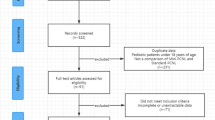Abstract
The aim of this study is to evaluate the efficacy and safety of one-shot versus gradual dilation technique for tract creation in percutaneous nephrolithotomy (PCNL). A systematic research of Pubmed, Embase and the Cochrane Library was performed to identify all relevant studies. The quality of the included trials was assessed and the data were extracted independently by two reviewers. The Cochrane Collaboration’s Review Manager (RevMan) 5.0.2 software was used for statistical analysis. Four randomized controlled trials were included in analysis involving 346 patients in total. Of these patients 174 were in the one-shot group and 172 in the gradual group. Our meta-analysis showed that there were no significant differences in successful dilation rate [risk ratio (RR): 0.96; 95 % confidence interval (CI): 0.92–1.00, p = 0.05], transfusion rate (RR: 0.62; 95 % CI: 0.20–1.96; p = 0.42), and hemoglobin decrease [mean difference (MD): −0.34; 95 % CI: from −0.67 to −0.00; p = 0.05] between one-shot dilation and gradual dilation. One-shot dilation had significant shorter access time (MD: −1.03; 95 % CI: from −1.57 to −0.49; p = 0.0002) and X-ray exposure time (MD: −42.71; 95 % CI: from −45.05 to −40.37; p < 0.00001) than gradual dilation. Our results show that One-shot dilation is an effective and safe procedure for tract creation in PCNL, with shorter access time and X-ray exposure time and without increased complications. As only four studies with small study populations were available, more high-quality larger trials with longer follow-up are recommended.




Similar content being viewed by others
Abbreviations
- PCNL:
-
Percutaneous nephrolithotomy
- RCTs:
-
Randomized controlled trials
- RR:
-
Risk ratio
- CI:
-
Confidence interval
- MD:
-
Mean difference
- Mini-PCNL:
-
Minipercutaneous nephrolithotomy
References
Segura JW, Patterson DE, LeRoy AJ, Williams HJ Jr, Barrett DM, Benson RC Jr, May GR, Bender CE (1985) Percutaneous removal of kidney stones: review of 1,000 cases. J Urol 134:1077–1081
Alken P, Hutschenreiter G, Günther R, Marberger M (1981) Percutaneous stone manipulation. J Urol 125:463–466
Rusnak B, Castaneda-Zuniga W, Kotula F, Herrera M, Amplatz K (1982) An improved dilator system for percutaneous nephrostomies. Radiology 144:174
Travis DG, Tan HL, Webb DR (1991) Single-increment dilation for percutaneous renal surgery: an experimental study. Br J Urol 68:144–147
Aminsharifi A, Alavi M, Sadeghi G, Shakeri S, Afsar F (2011) Renal parenchymal damage after percutaneous nephrolithotomy with one-stage tract dilation technique: a randomized clinical trial. J Endourol 25:927–931
Higgins JPT, Green S (2008) Cochrane handbook for systematic reviews of interventions version 5.0.2 (updated September 2009). The Cochrane Collaboration
Moher D, Liberati A, Tetzlaff, Altman DG (2009) Preferred reporting items for systematic reviews and meta-analyses: the PRISMA statement. BMJ 339:b2535
Frattini A, Barbieri A, Salsi P, Sebastio N, Ferretti S, Bergamaschi E, Cortellini P (2001) One shot: a novel method to dilate the nephrostomy access for percutaneous lithotripsy. J Endourol 15:919–923
Amjadi M, Zolfaghari A, Elahian A, Tavoosi A (2008) Percutaneous nephrolithotomy in patients with previous open nephrolithotomy: one-shot versus telescopic technique for tract dilatation. J Endourol 22:423–425
Falahatkar S, Neiroomand H, Akbarpour M, Emadi SA, Khaki N (2009) One-shot versus metal telescopic dilation technique for tract creation in percutaneous nephrolithotomy: comparison of safety and efficacy. J Endourol 23:615–618
Ziaee SA, Karami H, Aminsharifi A, Mehrabi S, Zand S, Javaherforooshzadeh A (2007) One-stage tract dilation for percutaneous nephrolithotomy: is it justified? J Endourol 21:1415–1420
Lojanapiwat B (2006) Previous open nephrolithotomy: does it affect percutaneous nephrolithotomy techniques and outcome? J Endourol 20:17–20
Vicentini FC, Gomes CM, Danilovic A et al (2009) Percutaneous nephrolithotomy: current concepts. Indian J Urol 25:4–10
de la Rosette JJ, Tsakiris P, Ferrandino MN et al (2008) Beyond prone position in percutaneous nephrolithotomy: a comprehensive review. Eur Urol 54:1262–1269
Conflict of interest
The authors declare that they have no conflict of interest.
Author information
Authors and Affiliations
Corresponding author
Additional information
Yutao Li and Lu Yang contributed equally to this work.
Rights and permissions
About this article
Cite this article
Li, Y., Yang, L., Xu, P. et al. One-shot versus gradual dilation technique for tract creation in percutaneous nephrolithotomy: a systematic review and meta-analysis. Urolithiasis 41, 443–448 (2013). https://doi.org/10.1007/s00240-013-0583-6
Received:
Accepted:
Published:
Issue Date:
DOI: https://doi.org/10.1007/s00240-013-0583-6




